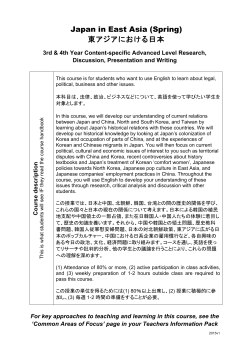
File
JAPANESE DESIGN CONCEPT: NOTAN Learning Targets: Demonstrate an understanding of the element of artshape by exploring negative and positive shapes/space using the design concept of Notan to achieve balance. Must Do: Develop an understanding of the Japanese design concept- Notan by learning about key concept associated with it, and apply it with the creation of a design based on the Notan concept of art. Create a cut design with positive and negative shapes. http://susanpm.blogspot.com/2012/04/week-of-notan-day-1.html • Island Nation located in Eastern Asian located in the Pacific Ocean/East of Sea of Japan • Often referred to as “Land of the Rising Sun”. • Population around 120 million. Cultural beliefs that guide Japanese Aesthetics Shinto-Buddhism (philosophy/belief system) • “…wholeness and appreciation of of nature….and its celebration of the landscape, things either evolve or fade away.” Worshipping of nature, belief that spirits reside in nature. • Wabi-sabi • “….mindful approach to everyday life….. beauty is an altered state of consciousness and can be seen in the mundane and simple.” • Shibui • “….beauty of simple, subtle, and unobtrusive beauty.” http://en.wikipedia.org/wiki/Japanese_aesthetics Zen Garden 18th-19th century tea bowl “Nōtan (濃淡?) is a Japanese design concept involving the play and placement of light and dark as they are placed next to the other in art and imagery.” • Use of Japanese design concept implies that beauty and harmony will be achieved. http://en.wikipedia.org/wiki/Notan Lightness and Darkness “As a guiding principle of Eastern art and design, Notan (a Japanese word meaning dark-light) focuses on the interaction between positive and negative shapes/space. In composition, it recognizes the separate but equally important identity of both a shape and its background.” http://www.3villagecsd.k12.ny.us/artsgelinas/new_page_16.htm Key Concepts Negative Space (Shape)space around and between the subject(s) of an image Positive Space (Shape)space that fills or gives an object shape Rubin’s Vase www.Wikipedia.com “This use of light and dark translates shape and form into flat shapes on a two-dimensional surface. Nōtan is traditionally presented in paint, ink, or cut paper, but it is relevant to a host of modern day image-making techniques, such as lithography in printmaking……” http://en.wikipedia.org/wiki/Notan It helps in creating a dynamic composition through balance. Composition “….is the placement or arrangement of visual elements or ingredients in a work of art, the …….organization of the elements of art according to the principles of art.” http://en.wikipedia.org/wiki/Composition_(visual_arts) http://www.mitchalbala.com/notan/ FORMATIVE ASSESSMENT: EXPLORING NEGATIVE AND POSITIVE SPACE WITH NOTAN DESIGN MUST DO: Explore the Elements of art: Positive/Negative space & shape Principles of Art: Balance Symmetry- perfectly even on both sides and balanced. Asymmetry- dissimilar elements but still appears balanced Contrast Create a work of art based on the Notan design concept with a focus on creating balance and harmony with the use of negative and positive space. Step 1: Using a 4x4 in. piece of black paper, draw 3 shapes on each side (organic or geometric) that all start and end on the outer edges of each side. Step 2: Cut out all your pieces (keep all of them). Put all of your pieces back in the exact shapes where you cut them out. Now flip your shapes directly out to create your design. Formative AssessmentSketchbook Page Exploring Negative and Positive Shape/Space Create your Notan design. Then somewhere on your page label the following information: 1) Label Page: Japanese Design Concept- Notan 2) Description/Definition of Notan 3) What the primary element of art that this design explores or shows? 4) What does the concept of Notan help you achieve in a work of art? 5) What type of balance is your design? 6) 1 interesting fact you learned about Japan. http://www.k6art.com/2013/02/20/notan-for-fifth-and-sixth-grades/
© Copyright 2025








